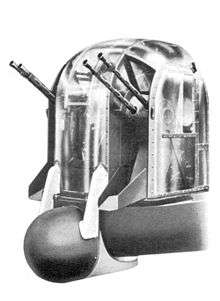Automatic Gun-Laying Turret
The Automatic Gun-Laying Turret (AGLT) was a British radar-aimed FN121 turret fitted to some Avro Lancaster and Handley Page Halifax bombers in 1944. The AGLT system was devised to allow a target to be tracked and fired-on in total darkness, the target's range being accurately computed as well as allowing for lead and bullet drop. The system was referred to by the codename Village Inn during development, and given the number TR3548.
The system was devised by a team led by Dr Philip Dee and designed under the aegis of chief designer Dr Alan Hodgkin, after receiving a request from the Air Ministry for such a system in early 1943. Village Inn was evaluated and tested by the Telecommunications Research Establishment (TRE) at RAF Defford using the Lancaster Mark I serial number ND712 Lancaster Mark III JB705 and Mk II LL736 and LL737 and subsequently put into production.
The system consisted of a transmitter/receiver unit mounted in the navigator's compartment, operating through a conical scanning parabolic aerial attached to the standard Frazer-Nash turret. It worked on a wavelength of 9.1 cm (3 GHz) with a pulse repetition frequency of 660 hertz. The magnetron used was the CV.186 of approx 35kW. The electronics sent a signal back to the turret, where it was displayed on a cathode ray tube (CRT) display screen positioned adjacent to the gun sight, the image of which was projected on to the Mark IIC gyro gunsight via a semi-transparent mirror.
Initially, ranging information was provided only at the transmitter situated in the navigator's compartment and was read off to the gunner over the intercom, the gunner using foot pedals to set the target range on the sight. In production equipment the process was made automatic, the range information being fed electronically directly into the gunsight, with the navigator's "running commentary" only being retained for the benefit of the rest of the crew. The gunner simply maneuvered his guns to place the "blip" in the centre of the gunsight's reticle, and opened fire when the range was appropriate. Windage, bullet drop and other factors were already calculated by the gunsight.

The first squadron to use Village Inn operationally was No. 101 Squadron RAF, based at Ludford Magna, in the autumn of 1944, followed soon afterwards by No. 49 in the attack on Darmstadt on September 11/12,[1] 156 and 635 Squadrons.

Village Inn was eventually produced in four Marks:
- AGLT Mark I — initial design — Airborne Radio Installation (ARI) 5559.
- AGLT Mark II — modified, improved, Mark I — soon discontinued — ARI 5561.
- AGLT Mark III — scanning aerial mounted remotely from turret. Scan independent of turret's movements — ARI 5562.
- AGLT Mark IV — ARI 5632
The system was also fitted to the Rose turret on at least one Avro Lincoln B.Mk II, although how many is not known.[2] Some Lincolns fitted with the Boulton Paul Type D tail turret also incorporated the equipment.[3]
A similar type of system was produced in the US by the Emerson Electric Company of St. Louis, Missouri, when an Emerson Model III tail turret was equipped with the Emerson APG8 Blind Tracking Radar and fitted to the Canadian-built Lancaster KB805. The system was found to have no advantages over the British system and the project was subsequently dropped.
See also
- Telecommunications Research Establishment
- RAF Defford
- List of World War II electronic warfare equipment
References
- ↑ "Archived copy" (PDF). Archived from the original (PDF) on 2011-07-17. Retrieved 2009-06-26.
- ↑
- ↑ "The Avro Lincoln", Flight, p. 59, 17 January 1946
External links
| Wikimedia Commons has media related to Village Inn (codename). |
- A photograph of a Village Inn-equipped 635 Sqn Lancaster
- Illustration of a 460 Sqn Lancaster I/III fitted with Village Inn
- A photograph of a Village Inn-equipped Rose Rice turret on an Avro Lincoln
- A photograph of a Village Inn-equipped twin .5 in turret on a Handley Page Halifax
- Village Inn (PDF)
- Eyewitness account of Village Inn testing on 460 Squadron
